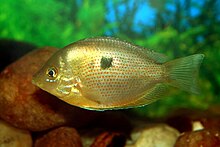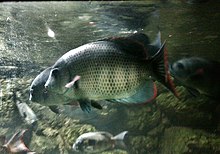Etroplinae
| Etroplinae | ||||||||||||
|---|---|---|---|---|---|---|---|---|---|---|---|---|

Striped cichlid ( Etroplus suratensis ) |
||||||||||||
| Systematics | ||||||||||||
|
||||||||||||
| Scientific name | ||||||||||||
| Etroplinae | ||||||||||||
| Van Couvering , 1982 |
Etroplinae are an ancient subfamily of the cichlids . Today they only live in the east and northwest of Madagascar and in southern India and Sri Lanka . Since it is primarily freshwater fish , some of which can tolerate a high salt concentration, they clearly demonstrate the continental drift . They must therefore have existed at least in the Upper Cretaceous when India separated from the east coast of Madagascar.
description
Most species have a rather high-backed, almost rounded, laterally strongly flattened body with a terminal, not particularly deeply cut mouth. What is striking is the high number of spine rays in the anal fin, compared to other cichlids. In Sparks (2008), detailed anatomical, morphological and DNA-sequence-based studies are summarized, and all Malagasy species are presented individually. One of the most striking anatomical features of all Etroplinae is a peculiarity of the swim bladder, which has a connection with the inner ear in the brain skull. In none of the numerous African or Neotropical cichlid species does the swim bladder come anywhere near the skull. It is difficult to differentiate between the sexes of the Etroplinae. All species form a parent family , are substrate spawners and take care of their brood with great sacrifice.
Systematics
Although Bleeker (1868) noticed the similarity of the Indian and Malagasy species and assumed a relationship, the subfamily was taxonomically delimited as Etroplinae by Van Couvering (1982). Kullander (1989) placed it in a phylogeny at the basal point and Sparks (2008) published what was initially the last concept of ancestral history. The name for the Etroplinae is derived from the genus Etroplus described first , which in turn is composed of the Greek words etron for "belly" and hoplon for "weapon" and refers to the prickly ventral and anal fins that protect the belly.
Genera and species

Indian species
-
Etroplus Cuvier 1830
- Etroplus canarensis Day 1877
- Etroplus suratensis (Bloch 1790)
-
Pseudetroplus Bleeker, 1862
- Pseudetroplus maculatus (Bloch 1795)
Malagasy species
-
Paretroplus Bleeker, 1868
- Paretroplus dambabe Sparks, 2002
- Paretroplus damii Bleeker, 1868
- Paretroplus gymnopreopercularis Sparks, 2008
- Paretroplus kieneri Arnoult, 1960
- Paretroplus lamenabe Sparks, 2008
- Paretroplus loisellei Sparks & Schelly, 2011
- Paretroplus maculatus Kiener & Maugé, 1966
- Paretroplus maromandia Sparks & Reinthal, 1999
- Paretroplus menarambo Allgayer, 1996
- Paretroplus nourissati (Allgayer, 1998)
- Paretroplus petiti Pellegrin, 1929
- Paretroplus polyactis Bleeker, 1878
- Paretroplus tsimoly Stiassny, Chakrabarty & Loiselle, 2001
Individual evidence
- ↑ Van Couvering, JAH (1982): Fossil cichlid fish of Africa. Special Papers in Palaeontology , 29 : 1-103.
- ↑ Kullander, SO (1998): A phylogeny and classification of the South American Cichlidae (Teleostei: Perciformes), pp. 461-498 in Phylogeny and Classification of Neotropical Fishes (LR Malabarba, RE Reis, RP Vari, ZM Lucena & CAS Lucena , eds.). 603 pp. EDIPUCRS: Porto Alegre.
- ↑ Sparks, JS (2008): Phylogeny of the cichlid subfamily Etroplinae and taxonomic revision of the Malagasy cichlid genus Paretroplus (Teleostei, Cichlidae). Bulletin of the American Museum of Natural History , 314 : 1-151. Texts
- ↑ Pethiyagoda, R., Maduwage, K. & Manamendra-Arachchi, K. (2014): Validation of the South Asian cichlid genus Pseudetroplus Bleeker (Pisces: Cichlidae). Zootaxa , 3838 (5): 595-600. doi: 10.11646 / zootaxa.3838.5.9
Web links
- Etroplinae on Fishbase.org (English)
- Eschmeyer, WN (ed.) Catalog of Fishes electronic version (6 May 2010). [1]
- Phylogeny

